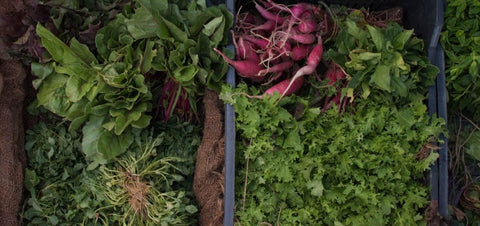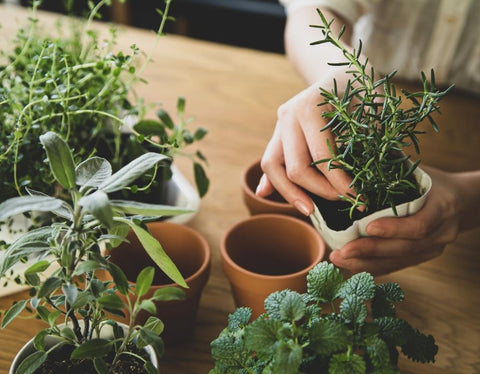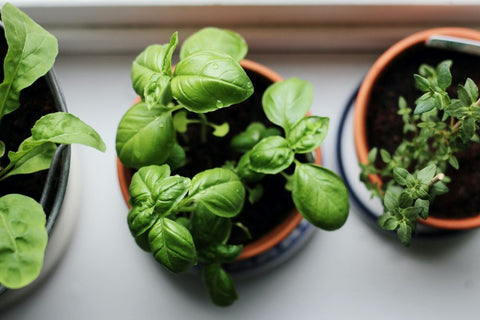Want to grow an indoor garden but not sure where to begin? In this blog, we’ll cover the main types of edible plants you can grow indoors, the basics they all need to survive, and our recommended progression—from beginner to advanced—so that you can develop the necessary skills to become an expert gardener quickly and confidently.
The Perfect Microgreens

Microgreens are harvested just after they sprout—typically 1-2 weeks after planting. Microgreens are fueled by the energy stored in their seed, which means you don’t need to worry about adding nutrients, light, or advanced skills that older plants need. The speed and ease of growing microgreens, combined with their diverse flavors and massive health benefits, make them the perfect edible plant to start with. You can read our overview of microgreens (and how they’re different from sprouts) here.
Lettuce, Herbs & Other Leafy Greens

If you let a single microgreen keep growing for a month or so, it will begin to turn into the larger leafy plants that you might be more familiar with—like lettuce, basil, radish, or kale (or lots of others). To get harvestable greens, you’ll need to give the plants a bit more light, nutrients, and care. While lettuce, herbs, and other leafy greens’ fast growth is impressive, their popularity as indoor edible plants likely stems from their performance in the kitchen. Once you get used to crisp, flavorful, just-picked greens, it’s hard to return to store-bought.
Cucumbers, Beans & Other “Early Harvest” Vegetables

The “Early Harvest” category gets its name from the fact that you harvest these vegetables before they are ripe (lest you want them to be tough and pithy). A couple of months after planting, they’ll start to put out flowers, which then become vegetables. There are a few tricks to help this transition from growing leaves to growing vegetables—including more light, more nutrients, and pollinating the flowers. The extra work has a rewarding payoff; picking vegetables young means weekly harvests, and the plants can be productive for up to a year. You’ll be amazed by some of the varieties of your favorite vegetables, as most store-bought ones are not bred for flavor but rather to be tough enough to survive shipping.
Tomatoes, Peppers & Other Ripe Vegetables

The ripe tomato is known as the “holy grail” of the garden, and for good reason: out of all vegetables, the homegrown tomato is furthest from its supermarket counterpart. It’s also a common target of pests and disease (you may have heard the gardening joke about the $64 dollar tomato), but when grown indoors, it’s not too hard or costly—they just take a bit more time than other plants. This category also has the most attractive plants with dark green foliage and colorful veggies, and they can keep producing for years.
What Do Plants Really Need To Thrive?

All plants require the same elements to grow productive harvests—just in different amounts. Brushing up on these basics might bring you back to grade school, but if you master these four elements, you can grow pretty much anything.
1. Grow Lights & Natural Light: Which Plants Need Which?
Light is the sole source of energy for all plants—it’s their food, so to speak. Just like an ant and an elephant need different amounts of food to survive, so do different plants. As a general rule, edible plants need much more light than houseplants. Further, things like making flowers and vegetables take a lot of energy, so plants need more light in those stages. If you want to dive deep, we’ve got an entire series of blogs and exercises that will help you understand, map, and modify your light environment.
2. How Much Water Do Plants Need?
Plants (like humans) are made up mostly of water, so obviously, they need it. Some need more, some need less. Some benefit from different amounts at different stages. Want to taste the sweetest tomato of your life? Keep the soil dryer as the fruit ripens to concentrate the sugars.
Don’t worry too much about the details for now as well-designed self-watering pots and hydroponics sets take most of the guesswork out of this.
3. Which Nutrients Do Plants Need?
You can think of plant nutrients like vitamins—they don’t provide energy, but they are essential building blocks that plants need to thrive. Outdoors, roots expand to find the nutrients they need in the soil. Indoors, the roots are limited to smaller containers, so you need to add them in. While all plants benefit from the same group of nutrients and minerals, at certain times in their development (when making a tomato, for example) they’ll benefit from a little “boost.”
4. How Should I Be Caring For My Plants?
Tending to your garden is great fun, and once you learn a few techniques, it will quickly become second nature. The basic actions you’ll take are: sprouting seeds, pruning leafy growth, pollinating flowers, and, of course, picking vegetables at their perfect ripeness.
Growing Your Garden: From Micros To ‘Maters
We recommend starting with the quick and simple growing techniques and building your way up to more advanced plants. At the end of the day, it ain’t rocket science, so if you want to jump right into ripe veggies, you should be successful as long as you follow the guidance in the corresponding section—it’s most important that you are growing things you actually want to eat.
| Microgreens | Leafy Greens | Early Harvest Vegetables | Ripe Fruits and Vegetables | ||
| Seed to table in… | 1 week | 1 month | 7 weeks+ 2 months |
4 months | |
| Light | Any light | Moderate | Moderate High |
High | |
| Care | sprout | sprout prune |
sprout prune pollinate |
sprout prune pollinate ripen |
|
| Nutrients | At setup | At setup + booster |
At setup + booster |
||
| Watering | set & forget | variety dependent | moist & consistent | moist & consistent dry when ripening |
|
| Harvestable Lifespan | 1 week | variety dependent | 1 year | Many years |
If you want more tips and tricks and to be part of an exclusive gardening community, then come join our private Facebook group. You can have 24/7 access to a community of indoor gardeners who help each other solve their gardening mysteries. We hope to see you there!








There are no comments for this article. Be the first one to leave a message!